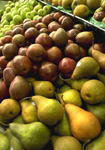| Sustainable Food Guide | Environmental Practice at Work © 2005  |
Issues | Biodiversity Information...
75% of European food product diversity has been lost since 1900 93% of American food product diversity has been lost in the same time period 33% of livestock varieties have disappeared or are near disappearing 30,000 vegetable varieties have become extinct in the last century, and one more is lost every six hours
The decrease in variability is not just between species; it is also within species. The increase in soybean production is parallel to a decrease in crop diversity as shown by the Simpson index, an indicator of variability, increased from 0,179 to 0,305 in the period 1997-2005 (Simpson index = 1 means total homogeneity). When the EU approves a GM variety, the manufacturers must demonstrate that it does not adversely affect biodiveristy. Yet, there is a lot more difference in biodiversity between crops than between a GM Crop and a non-GM crop. e.g Hemp plants encourage a lot of other plants and animals that a traditional wheat crop - or GM wheat crop. As there is no requirement during Pesticide Approval for pesticide manufacturers to demonstrate that the application of the pesticde reduces biodiverity - which they clearly, and are intended to, do. Cartegena Protocol on Biosafety seeks to protect biological diversity from the potential risks posed by living genetically modified organisms (GMOs). An advance informed agreement (AIA) procedure ensures that countries are provided with the information necessary to make informed decisions before agreeing to the import of such organisms into their territory. More on GM. Intellectual Property. How do we ensure that the people who have taken care of various local genetic resources for generations should be properly recognised in terms of ownership of these materials? Intellectual property rights (IPRs) are considered the principal mechanisms available to facilitate the sustainable use of the “components of biological diversity” and thereby link indigenous and sustainability issues with biotechnology and global trade. This is dealth with through WTO and TRIPs. TRIPS raises important questions about the ethics of ownership of genetic materials we depend on for food. Discussion from New Agriculturalist | |||||||


